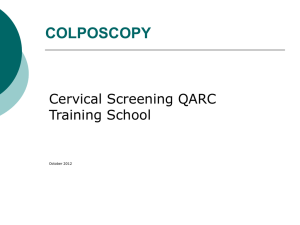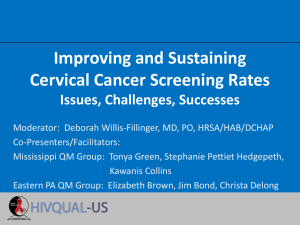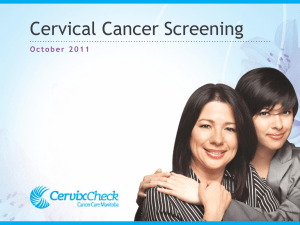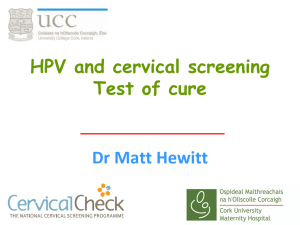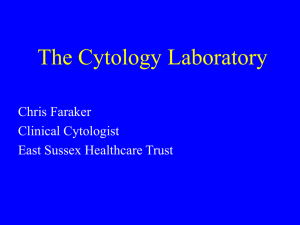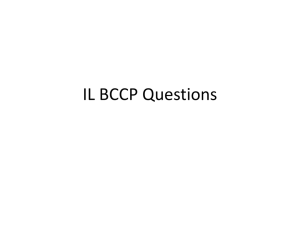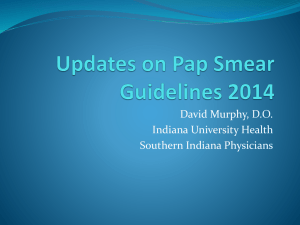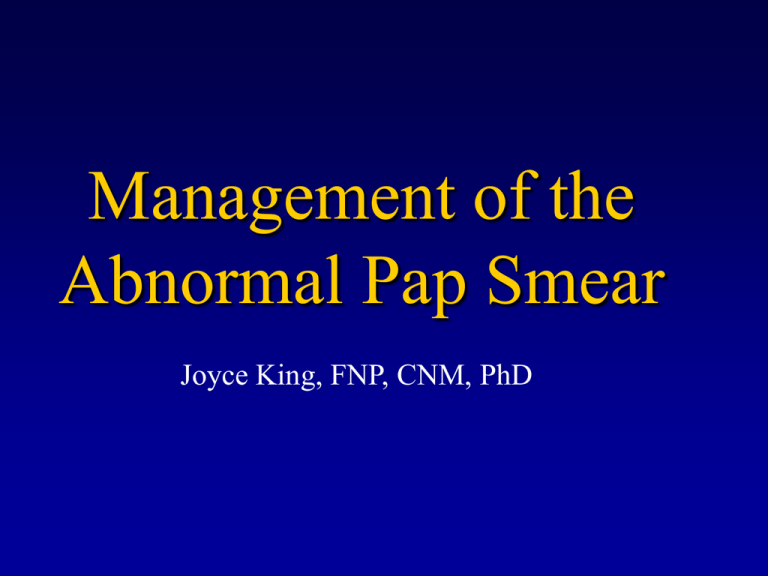
Management of the
Abnormal Pap Smear
Joyce King, FNP, CNM, PhD
Disclosure
• “I have no real or perceived vested
interests that relate to this presentation
nor do I have any relationships with
pharmaceutical companies, biomedical
device manufacturers, and/or other
corporations whose products or services
are related to pertinent therapeutic
areas.”
Objectives
• Discuss the epidemiology of cervical disease.
• Discuss the physiology of the normal cervix.
• Describe the correct techniques for Pap
smear testing.
• Understand the Bethesda system of reporting
Pap smear results.
• Review current guidelines for management of
abnormal results.
Cervical Cancer - Epidemiology
• Estimated 11,070 new cases of invasive
cervical cancer are expected to be
diagnosed in 2008.
• Estimated 3,870 deaths from cervical cancer
during this same time period.
• Most cases are found in women younger
than age 50.
• Risk is highest in Hispanic women and
African -American women.
Risk Factors for Cervical Cancer
• HPV infection – factors that promote
infection to progress to cancer
–
–
–
–
–
Immunosuppression
High parity
Cigarette smoking
Long-term use of oral contraceptives
Nutritional factors
• Women who begin having sex at an early age.
• Multiple sexual partners.
Human Papilloma Virus
• > 100 types
• Sexually transmitted infection
• High-risk types - 16, 18, 26, 31, 33, 35, 39,
45, 51, 52, 56, 58, 59, 66, 68, 73, 82
– Based on oncogenic potential
High-Risk HPV Infection
• 80% of infected women clear the virus in
6-8 months
• 20% develop cervical dysplasia
– 80% virus clears
– 20% infection persists
How Dies HPV Cause
Cervical Cancer?
• High-risk HPV exerts oncogenic activity
through the oncoproteins E6 and E7.
• These oncoproteins bind to tumor
suppressor gene products.
• This interaction leads to DNA changes and
genetic instability, allowing oncogenic
alterations.
How Dies HPV Cause
Cervical Cancer?
• The length of time between initial infection
and invasive cervical cancer is estimated to
be 10-15 years
• This length of time suggests that the
development of cancer requires changes in
the genome of HPV infected cells.
• Low and intermediate risk HPV have been
found in abnormal Pap smears, but not in
invasive cancers.
Signs and Symptoms of
Cervical Cancer
• Abnormal vaginal bleeding
– Between menses.
– After sexual intercourse, douching, or a pelvic
exam.
– Menstrual bleeding may last longer and be
heavier than usual.
– Bleeding after menopause
• Increased vaginal discharge
• Pain with intercourse
Prevention of Cervical Cancer
• Monogamy
• Condoms
• HPV Vaccine (Gardisil®)
– Highly immunogenic for HPV 6, 11, 16, 18
– Recommended for all girls and young women
between 9 and 26 years-of-age
The Normal Cervix
Physiology of the Cervix
• Types of cells
– Columnar – Line the endocervix
– Squamous – Line the ectocervix and vagina
Squamocolumnar Junction (SJC)
• Original- border where original squamous
cells meet columnar cells.
• Present- innermost border where maturing
squamous cells meet native columnar cells.
Transformation Zone
• Area of actively maturing epithelium
between present SCJ and original SCJ
– 90% of neoplasias occur in this area
Original
Squamous
Epithelium
Exocervix
Transformation Zone
Columnar
Epithelium
Squamous Metaplasia
Original
Squamocolumnar Junction
Present
Squamocolumnar Junction
Endocervix
Squamous Metaplasia
• Normally occurring transition of columnar
cells to squamous epithelium
– Due to lowered vaginal pH in response to
increased estrogen
– Process occurs in transformation zone
Puberty
Reproductive Years
Menopause
The Pap Smear
Pap Smear
• Historically, cytologic evaluation of
cervical and vaginal cells was first proposed
by Dr. Papanicolaou in the 1940’s, as a
method of detecting cervical cancer and
precursors.
• This evaluation has proved to be the most
cost effective method of cancer screening of
the cervix to date.
The Benefit of the Pap Test
• Since the introduction of the Pap smear,
there has been a substantial decrease in the
incidence of invasive cervical cancer as
well as death from cervical cancer.
ACS Recommendations for Pap
Smear Screening
• Begin at age 21 or three years after
initiating sexual activity.
• Annual pap smears - Ages 21-30 (with
liquid-based cytology, testing can be every
2 years).
• Beginning at age 30 – with 3 normal Pap
test in a row, may be tested every 2 to 3
years, OR
ACS Recommendations for Pap
Smear Screening
• Test every 3 years with either the regular
Pap test or liquid-based Pap test, plus the
HPV DNA test.
• Women 70 years of age and older may
choose to stop having Pap testing
– 3 or more normal Pap tests in a row
– No abnormal Pap test results in the
last 10 years
ACS Recommendations for Pap
Smear Screening
• Women with a total hysterectomy due to
benign causes do not need Pap testing.
• Women with a simple hysterectomy (still
have cervix) need to follow the above
guidelines.
Epidemiology of Abnormal
Pap Tests
• More than 50 million
Pap tests each year in
the US
• 5% of all pap smears
are abnormal
• More than 95% of all
cervical cancers
exhibit evidence of
HPV
J. Natl. Cancer Inst. 2008 100:841; doi:10.1093/jnci/djn192
Sampling Technique
– Endocervical canal
– Exocervical Transformation Zone
Guidelines for Obtaining
• Use largest speculum that allows
for good visualization but is
comfortable.
• Inspect cervix for abnormalities
• Use the contoured end of the
spatula and rotate 360 degrees
while maintaining firm contact
• Insert cervical brush into os and
rotate 90 - 180 degrees, OR
• Use brush designed to retrieve
both types of cells and rotate 360
degrees
Pitfalls in Cervical Cytology –
Patient-related
• Recent douching
• Recent sexual intercourse
• Heavy discharge, blood or vaginal creams
• Lack of follow-up of abnormal findings
Pitfalls in Cervical Cytology –
Practitioner-related
• Inappropriate sampling
• Inadequate endocervical cells
• Too thickly spread on slide
• Delay in fixation
• Screening errors
• Lack of follow-up
Pitfalls in Cervical Cytology –
Lab-related
• Confusing terminology
• Missed diagnosis
– False positive
– False negative
Improvements in Testing
• Liquid-based smears
• Rescreening strategies - computerized
devices (AutoPap®)
• HPV DNA testing
Bethesda System of Reporting
• The Bethesda System (TBS) of reporting
Pap smear results was developed in 1988,
and revised in 1998 and 2001.
• The purpose was to standardize cervical and
vaginal cytopathologic reporting and to
facilitate communication between clinicians
and cytopathologists.
Bethesda 2001 Terminology
• Specimen Adequacy
– Satisfactory for evaluation
• Unsatisfactory for evaluation
– Specimen rejected/not processed
– Specimen processed and examined, but
unsatisfactory for evaluation of epithelial
abnormality because (specify reason)
Bethesda System of Reporting
• General categories
– Negative for intraepithelial lesions or
malignancy
– Epithelial cell abnormalities
– Other malignant neoplasms
Epithelial Cell Abnormalities
• Atypical squamous cells –
– of undetermined significance (ASC-US)
• Infection
• Irritation
• Precancer
– cannot exclude HSIL (ASC-H)
Epithelial Cell Abnormalities
• Low grade squamous intraepithelial lesion
(LSIL)
– Encompassing mild dysplasia/CIN1(cervical
intraepithelial neoplasia)
• High grade squamous intraepithelial lesion
(HSIL)
– Encompassing moderate and severe dysplasia,
CIN 2,3
• Squamous cell carcinoma
Natural History of Cervical
Dysplasias
• Approximately 66% of ASC-US will
resolve spontaneously
• Approximately 50% of LSIL will resolve
spontaneously
• Approximately 33% of HSIL will resolve
spontaneously
• Of those that regress, most will do so in
6 months
HPV DNA Test
• Does not replace the Pap test
• Not recommended for a screening test in
women under 30
• Used in women of any age who have
slightly abnormal Pap test results
– Low-risk HPV
– High-risk HPV
Other Tests Used with Abnormal
Cervical Cytology
• Colposcopy
• Cervical biopsies
–
–
–
–
Colposcopic biopsy
Endocervical curettage
Cone biposy
LEEP
Case #1
B.S. is a 21 y.o. 0030
that presented to your
clinic for a Pap test
one week ago. Her
results indicated ASCUS. How should this
result be managed?
Management of ASC-US (age >20 )
• HPV DNA testing preferred if liquid based
sampling
– HPV + - Colposcopy
– HPV - - Repeat cytology in 12 months
• Repeat cytology at 6 and 12 months
– Both test negative – routine screening
– Continues with ASC – colposcopy
• Colposcopy
Management of ASC-US (age >20 )
• Colposcopy
– No CIN
• HPV unknown – repeat Pap in 12 months
• HPV postive – repeat Pap in 6 & 12 months with
HPV DNA testing at 12 months
– CIN – Manage per ASCCP (American Society
for Colposcopy and Cervical Pathology
Guideline)
Management of ASC-US or LSIL
(age <20 )
• Repeat cytology at 12 months
– ≥ HSIL – Colposcopy
– ≤ HSIL – Repeat cytology in 12 months
• ≥ ASC - Colposcopy
Management of ASC-H
• Colposcopy and biopsy
– No CIN 2,3
• Cytology at 6 & 12 months
• HPV DNA testing at 12 months
Management of LSIL (age >20)
• Colposcopy and endocervical sampling
– No CIN 2,3
• Cytology at 6 & 12 months
• HPV DNA testing at 12 months
Case #2
S.J., a 37 year old 5026 presents for her
GYN exam. Her last exam was 7 years ago.
She complains of postcoital spotting during
the previous 2 months. Her past history
reveals that her first sexual exposures was at
16 and that she has had 7 lifetime partners.
Her Pap smear showed HSIL. How should
this patient be managed?
Management of HSIL (age >20)
• Immediate loop electrosurgical excision OR
• Colposcopy – No CIN 2,3
– Unsatisfactory colposcopy – diagnostic
excisional procedure
– Satisfactory colposcopy
• Observation with colposcopy & cytology at 6 month
intervals for 1 year
• Diagnostic excisional procedure
• Review material
Management of HSIL (age < 20)
• Colposcopy – Satisfactory exam and no
CIN 2,3
– Observation with colposcopy & cytology at 6
months intervals for up to 2 years
• HSIL persists for 1 year – biopsy, if no CIN 2,3,
continue observation
• HSIL persists for 24 months with no CIN 2,3
identified – diagnostic excisional procedure
Management in Pregnancy
• Only indication for treatment is if invasive
carcinoma is present
• Defer colposcopy for those pregnant women
at low risk for having cancer
Treatment for Dysplasias
• Cryotherapy
• Laser ablation
• Loop electrosurgical excision procedure
(LEEP)
Cryotherapy
• Indications
–
–
–
–
–
CIN 1,2
Small lesion
Ectocervical location
Negative ECC
No endocervical glad involvement
Cryotherapy
• Advantages
– Reliability
– Ease of use
– Low cost
• Disadvantages
– Inability to tailor to
lesion size
– No pathologic specimen
Laser Ablation
• Indications
–
–
–
–
–
CIN 1-3
Large lesions
Irregular cervix
Vaginal extension of dysplasia
Satellite lesions
Laser Ablation
• Advantages
– Reliability
– Can be tailored to
lesion size
– Rapid healing
• Disadvantages
– Expensive
equipment/training
– Complications (e.g.
burns)
– No pathologic
specimen
LEEP (Loop Electrosurgical
Excision Procedure)
• Indications
–
–
–
–
CIN 1-3
Unsatisfactory colposcopy
Positive ECC
Significant discrepancy between cytology and
histology
– Suspicion of invasion
– Glandular dysplasia
LEEP
• Advantages
– Reliability
– Ease of use
– Can be tailored to
lesion size
– Produces pathologic
specimen
• Disadvantages
– High cost
Epithelial Cell Abnormality Glandular Cells
• Atypical glandular cells
– Endocervical
– Endometrial
– Cervical glandular cells
Note: The AGC lesions are associated with
much greater risk for cervical neoplasia
than ASC or LSIL
Epithelial Cell Abnormality Glandular Cells
• Adenocarcinoma in situ
– Precursor of invasive cervical adenocarcinoma
– Always evaluated by diagnostic excisional
procedures
– If fertility is undesired – hysterectomy is
recommended
Treatment of Abnormal
Glandular Cells
• All abnormal glandular cells get colposcopy
and HPV DNA testing and endometrial
sampling (if >35 years or at risk for
endometrial neoplasia), EXCEPT
• If atypical endometrial cells are present on
the Pap test. This indicates endometrial and
endocervical sampling; if no abnormal
endometrial pathology then colposcopy.
Future Screening Methods
• Fluorescence spectroscopy
• Polar probe
• Molecular markers
Treatment for Cervical Cancer
• Staging
• Surgery
–
–
–
–
–
–
Cryosurgery
Laser surgery
LEEP
Cold knife conization
Hysterectomy
Radical trachelectomy
• Radiation
• Chemotherapy
Summary
• Cervical disease is predominately a sexually
transmitted disease.
• Adequate retrieval and preparation of cells
is imperative.
• Regular Pap smears does reduce the
incidence of invasive cervical cancer.
• HPV testing is important and helps to guide
the management of abnormal Pap tests.
Summary cont’d
• Treatment of abnormal Pap smears is based
on risk factors and degree of severity of the
lesions.
• New screening techniques are on the
horizon.
• Vaccine for prevention is here and should
be encouraged.

